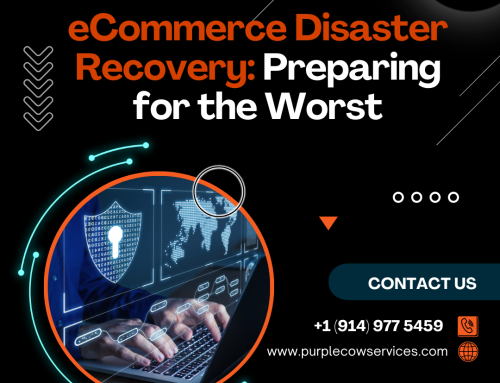The eCommerce industry, with its rapid growth and ever-increasing reliance on digital platforms, faces unique challenges when it comes to disaster recovery.
Share This Story, Choose Your Platform!
In this comprehensive guide, we will delve into the critical importance of disaster recovery in eCommerce. We will explore the potential risks that eCommerce businesses face, the elements of a robust recovery plan, and how preparedness can not only help your eCommerce business survive but also thrive in the face of adversity.
The eCommerce Boom and Its Vulnerabilities
In recent years, the eCommerce sector has experienced explosive growth, driven by the convenience and accessibility of online shopping. This unprecedented expansion has positioned eCommerce businesses at the forefront of the global economy. However, this rapid growth has also made these businesses more vulnerable to disruptions and disasters.
Why eCommerce is particularly susceptible to disasters
Digital Dependence
eCommerce businesses are inherently digital. Your website serves as your primary storefront, and any disruption to its availability can result in immediate revenue loss. Customers who cannot access your site will quickly turn to competitors, and the damage to your brand’s reputation can be long-lasting.
Cybersecurity Threats
The digital nature of eCommerce makes it a prime target for cyberattacks. From data breaches to ransomware attacks, cyber threats can lead to data loss, financial damage, and operational downtime. The consequences of a cybersecurity incident can extend far beyond the initial breach, affecting customer trust and brand credibility.
Supply Chain Disruptions
eCommerce businesses rely on complex supply chains to source, store, and deliver products to customers. Disruptions in the supply chain, whether due to natural disasters or unforeseen circumstances, can lead to inventory shortages and delayed deliveries. These disruptions can result in dissatisfied customers and revenue loss.
Customer Expectations
In the world of eCommerce, customers expect a seamless and convenient shopping experience. Any disruption, even if temporary, can lead to customer frustration and potential churn. Meeting these high customer expectations is vital for eCommerce success.
The Consequences of Not Being Prepared
Imagine a scenario where your eCommerce business falls victim to a disaster without a recovery plan in place. What could be the potential consequences?
Revenue Loss
Operational downtime can result in immediate and substantial revenue loss. Every minute your website is inaccessible or your systems are down equates to lost sales opportunities. The financial implications can be significant.
Damage to Reputation
A major disruption can tarnish your brand’s reputation. Customers who experience issues during their shopping journey may share their negative experiences with others, both online and offline. This negative word-of-mouth can harm your brand image and deter potential customers.
Legal and Financial Consequences
Data breaches or other cybersecurity incidents can lead to legal and financial liabilities. Fines, lawsuits, and compliance issues can result from mishandling customer data. Addressing these legal and financial challenges can be costly and time-consuming.
Competitive Disadvantage
Your competitors are just a click away. If your eCommerce site is down or experiences significant disruptions, customers will turn to alternatives. This can lead to long-term market share loss, as customers may develop loyalty to competitors during your downtime.
The Essential Elements of an eCommerce Disaster Recovery Plan
Now that we’ve established the significance of disaster recovery in eCommerce, let’s outline the essential elements of a robust recovery plan:
Risk Assessment
Begin by identifying potential risks specific to your eCommerce business. Consider both internal and external threats, including natural disasters, cyber threats, and system failures. Understanding your vulnerabilities is the first step in disaster preparedness.
Business Impact Analysis
Evaluate how each potential disaster could impact your eCommerce operations. Determine the financial implications, customer experience disruptions, and supply chain interruptions associated with each scenario. This analysis will help prioritize recovery efforts.
Data Backup and Recovery
Implement a robust data backup and recovery strategy. Regularly back up all critical data, including customer information, transaction records, and inventory data. Ensure these backups are securely stored and easily retrievable. Data is the lifeblood of eCommerce, and its loss can have catastrophic consequences.
Redundancy and Failover Systems
To minimize downtime, invest in redundancy and failover systems. These technologies can automatically switch to backup servers or systems if the primary ones fail, ensuring continuous service availability. Redundancy is especially crucial for eCommerce websites that operate 24/7.
Cybersecurity Measures
Protect your eCommerce business against cyber threats with strong cybersecurity measures. Implement firewalls, encryption, intrusion detection systems, and regular security audits to safeguard customer data and sensitive information. Regularly update your security protocols to stay ahead of evolving threats.
Employee Training
Ensure that your employees are well-trained in disaster response procedures. They should know their roles and responsibilities in the event of a disaster, whether it’s a cyber incident or a physical disruption. Training and awareness are critical components of an effective recovery plan.
Communication Plan
Establish a clear and effective communication plan. This plan should include notifying customers of any disruptions, updating stakeholders on recovery progress, and coordinating with third-party service providers. Open and transparent communication during a crisis can help maintain trust and confidence.
Regular Testing and Updates
Regularly test your disaster recovery plan to identify weaknesses and areas for improvement. Ensure that all software and hardware are up-to-date to mitigate vulnerabilities. Keep your recovery plan dynamic and adaptable to address emerging threats and changes in your eCommerce environment.
Compliance and Legal Considerations
Stay compliant with relevant data protection and privacy regulations. Understand the legal requirements and responsibilities associated with customer data in the event of a breach. Compliance not only helps avoid legal repercussions but also demonstrates your commitment to protecting customer privacy.
Vendor Relationships
Maintain strong relationships with key vendors and service providers. These partnerships can be invaluable in expediting recovery efforts and minimizing downtime. Work closely with your vendors to align their disaster recovery capabilities with your own.
How Being Prepared Leads to eCommerce Resilience
A well-structured disaster recovery plan is more than just a safety net—it’s a blueprint for resilience. Here’s how being prepared can lead to eCommerce resilience:
Minimized Downtime
With a robust recovery plan in place, you can minimize downtime. Quick response and restoration of services help prevent significant revenue loss and maintain customer trust. Your ability to swiftly recover from a disaster sets you apart from competitors who may struggle to resume operations.
Brand Reputation Preservation
Effective disaster recovery preserves your brand’s reputation. By addressing disruptions promptly and transparently, you can demonstrate your commitment to customer satisfaction and loyalty. Customers are more likely to trust and continue doing business with brands that handle crises professionally and ethically.
Legal and Financial Protection
Compliance with legal requirements and data protection regulations can protect your eCommerce business from costly legal consequences. Being prepared means you can respond to data breaches with confidence, minimizing potential financial liabilities and regulatory penalties.
Competitive Advantage
eCommerce resilience can give you a significant competitive advantage. While competitors may face prolonged downtime or struggle to recover from disasters, your preparedness allows you to continue serving customers without interruption. This competitive edge can lead to increased market share and customer loyalty.
Conclusion
In the dynamic and competitive world of eCommerce, disasters can strike at any time. However, by planning, preparing, and implementing a robust disaster recovery strategy, you can prevail in the face of adversity. The importance of disaster recovery in eCommerce cannot be overstated—it’s the key to maintaining operations, safeguarding your brand, and securing your business’s future success. Don’t wait for disaster to strike; start building your eCommerce resilience today. Your ability to plan, prepare, and prevail will set you on the path to long-term success in this ever-evolving industry.
Unlock eCommerce Resilience with Purple Cow
At Purple Cow, we understand the pivotal role of disaster recovery in eCommerce. Our expert solutions ensure your online business remains robust, even in the face of adversity. With comprehensive risk assessment, cutting-edge cybersecurity measures, and 24/7 support, we fortify your eCommerce venture. Don’t just survive disruptions; thrive with Purple Cow‘s disaster recovery expertise. Secure your eCommerce future today!
Share This Story, Choose Your Platform!
In This Blog:

















